Kaufland's Business Strategy and Environment in Norway
VerifiedAdded on 2023/01/06
|8
|3110
|38
Report
AI Summary
This report provides a comprehensive analysis of Kaufland's potential business operations in Norway. It begins with an introduction to the global economy and the factors influencing business performance, followed by a background of Kaufland as a hypermarket chain and its expansion plans. The main body of the report employs the PESTLE framework to assess the political, economic, social, technological, environmental, and legal factors influencing Kaufland's prospects in Norway, highlighting Norway's political stability, economic strength, social environment, technological advancements, environmental considerations, and legal landscape. Furthermore, the report utilizes Porter's Five Forces model to evaluate the competitive dynamics within the Norwegian hypermarket industry, including competition, potential new entrants, supplier power, customer power, and the threat of substitutes. The analysis concludes that Norway offers a favorable business environment for Kaufland, supported by various positive factors, and provides insights into the strategic considerations for market entry and operations.
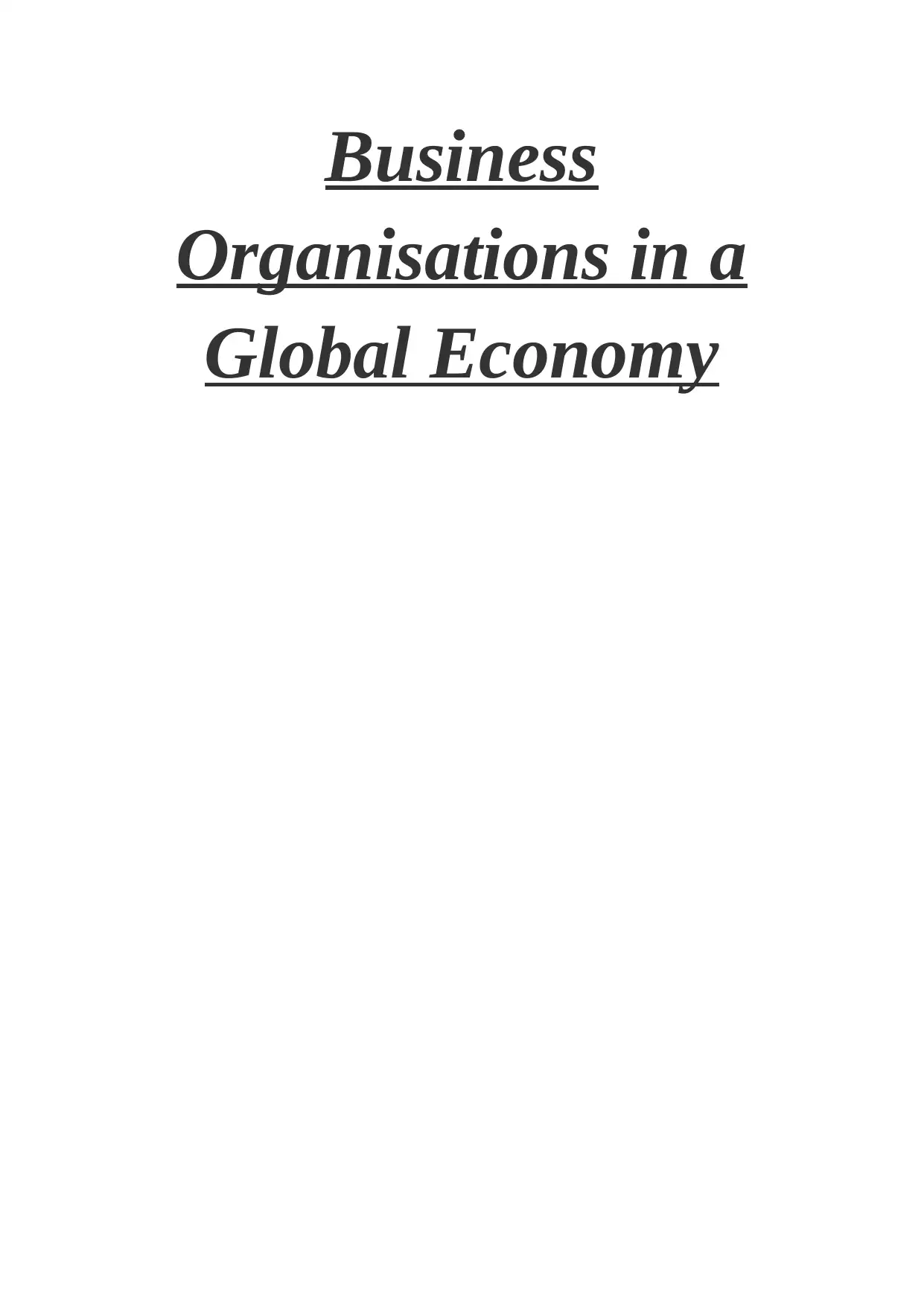
Business
Organisations in a
Global Economy
Organisations in a
Global Economy
Paraphrase This Document
Need a fresh take? Get an instant paraphrase of this document with our AI Paraphraser
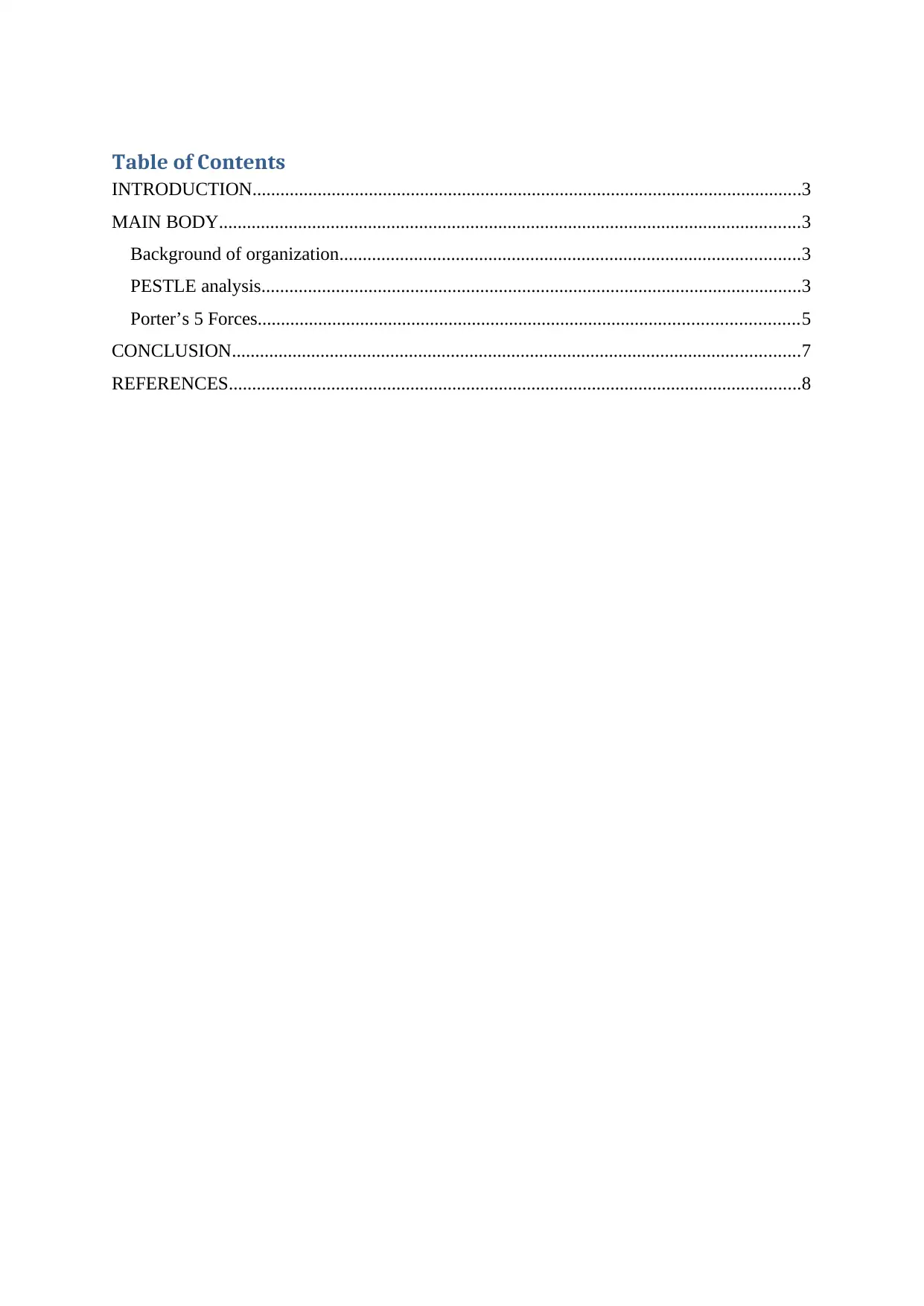
Table of Contents
INTRODUCTION......................................................................................................................3
MAIN BODY.............................................................................................................................3
Background of organization...................................................................................................3
PESTLE analysis....................................................................................................................3
Porter’s 5 Forces....................................................................................................................5
CONCLUSION..........................................................................................................................7
REFERENCES...........................................................................................................................8
INTRODUCTION......................................................................................................................3
MAIN BODY.............................................................................................................................3
Background of organization...................................................................................................3
PESTLE analysis....................................................................................................................3
Porter’s 5 Forces....................................................................................................................5
CONCLUSION..........................................................................................................................7
REFERENCES...........................................................................................................................8
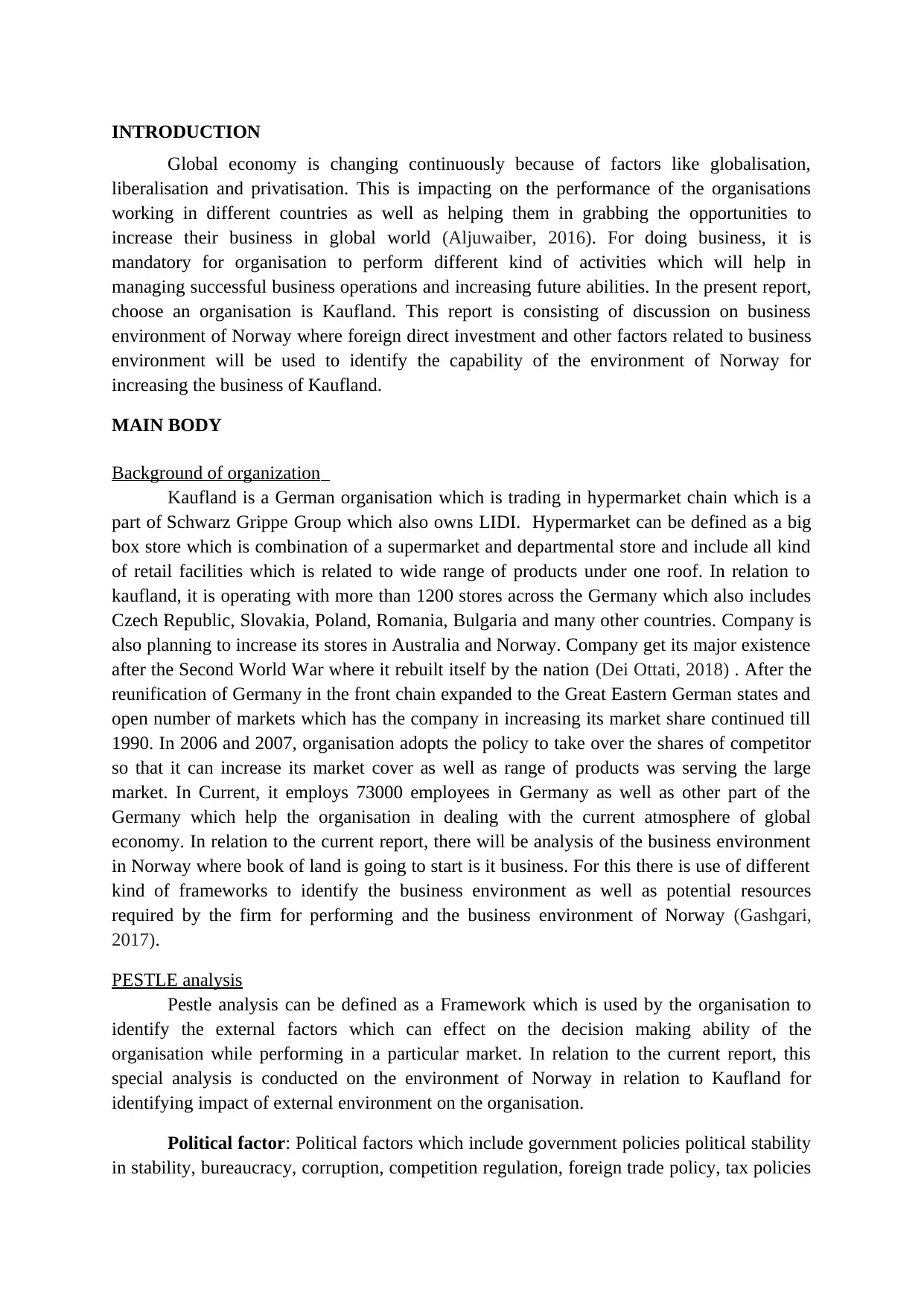
INTRODUCTION
Global economy is changing continuously because of factors like globalisation,
liberalisation and privatisation. This is impacting on the performance of the organisations
working in different countries as well as helping them in grabbing the opportunities to
increase their business in global world (Aljuwaiber, 2016). For doing business, it is
mandatory for organisation to perform different kind of activities which will help in
managing successful business operations and increasing future abilities. In the present report,
choose an organisation is Kaufland. This report is consisting of discussion on business
environment of Norway where foreign direct investment and other factors related to business
environment will be used to identify the capability of the environment of Norway for
increasing the business of Kaufland.
MAIN BODY
Background of organization
Kaufland is a German organisation which is trading in hypermarket chain which is a
part of Schwarz Grippe Group which also owns LIDI. Hypermarket can be defined as a big
box store which is combination of a supermarket and departmental store and include all kind
of retail facilities which is related to wide range of products under one roof. In relation to
kaufland, it is operating with more than 1200 stores across the Germany which also includes
Czech Republic, Slovakia, Poland, Romania, Bulgaria and many other countries. Company is
also planning to increase its stores in Australia and Norway. Company get its major existence
after the Second World War where it rebuilt itself by the nation (Dei Ottati, 2018) . After the
reunification of Germany in the front chain expanded to the Great Eastern German states and
open number of markets which has the company in increasing its market share continued till
1990. In 2006 and 2007, organisation adopts the policy to take over the shares of competitor
so that it can increase its market cover as well as range of products was serving the large
market. In Current, it employs 73000 employees in Germany as well as other part of the
Germany which help the organisation in dealing with the current atmosphere of global
economy. In relation to the current report, there will be analysis of the business environment
in Norway where book of land is going to start is it business. For this there is use of different
kind of frameworks to identify the business environment as well as potential resources
required by the firm for performing and the business environment of Norway (Gashgari,
2017).
PESTLE analysis
Pestle analysis can be defined as a Framework which is used by the organisation to
identify the external factors which can effect on the decision making ability of the
organisation while performing in a particular market. In relation to the current report, this
special analysis is conducted on the environment of Norway in relation to Kaufland for
identifying impact of external environment on the organisation.
Political factor: Political factors which include government policies political stability
in stability, bureaucracy, corruption, competition regulation, foreign trade policy, tax policies
Global economy is changing continuously because of factors like globalisation,
liberalisation and privatisation. This is impacting on the performance of the organisations
working in different countries as well as helping them in grabbing the opportunities to
increase their business in global world (Aljuwaiber, 2016). For doing business, it is
mandatory for organisation to perform different kind of activities which will help in
managing successful business operations and increasing future abilities. In the present report,
choose an organisation is Kaufland. This report is consisting of discussion on business
environment of Norway where foreign direct investment and other factors related to business
environment will be used to identify the capability of the environment of Norway for
increasing the business of Kaufland.
MAIN BODY
Background of organization
Kaufland is a German organisation which is trading in hypermarket chain which is a
part of Schwarz Grippe Group which also owns LIDI. Hypermarket can be defined as a big
box store which is combination of a supermarket and departmental store and include all kind
of retail facilities which is related to wide range of products under one roof. In relation to
kaufland, it is operating with more than 1200 stores across the Germany which also includes
Czech Republic, Slovakia, Poland, Romania, Bulgaria and many other countries. Company is
also planning to increase its stores in Australia and Norway. Company get its major existence
after the Second World War where it rebuilt itself by the nation (Dei Ottati, 2018) . After the
reunification of Germany in the front chain expanded to the Great Eastern German states and
open number of markets which has the company in increasing its market share continued till
1990. In 2006 and 2007, organisation adopts the policy to take over the shares of competitor
so that it can increase its market cover as well as range of products was serving the large
market. In Current, it employs 73000 employees in Germany as well as other part of the
Germany which help the organisation in dealing with the current atmosphere of global
economy. In relation to the current report, there will be analysis of the business environment
in Norway where book of land is going to start is it business. For this there is use of different
kind of frameworks to identify the business environment as well as potential resources
required by the firm for performing and the business environment of Norway (Gashgari,
2017).
PESTLE analysis
Pestle analysis can be defined as a Framework which is used by the organisation to
identify the external factors which can effect on the decision making ability of the
organisation while performing in a particular market. In relation to the current report, this
special analysis is conducted on the environment of Norway in relation to Kaufland for
identifying impact of external environment on the organisation.
Political factor: Political factors which include government policies political stability
in stability, bureaucracy, corruption, competition regulation, foreign trade policy, tax policies
⊘ This is a preview!⊘
Do you want full access?
Subscribe today to unlock all pages.

Trusted by 1+ million students worldwide
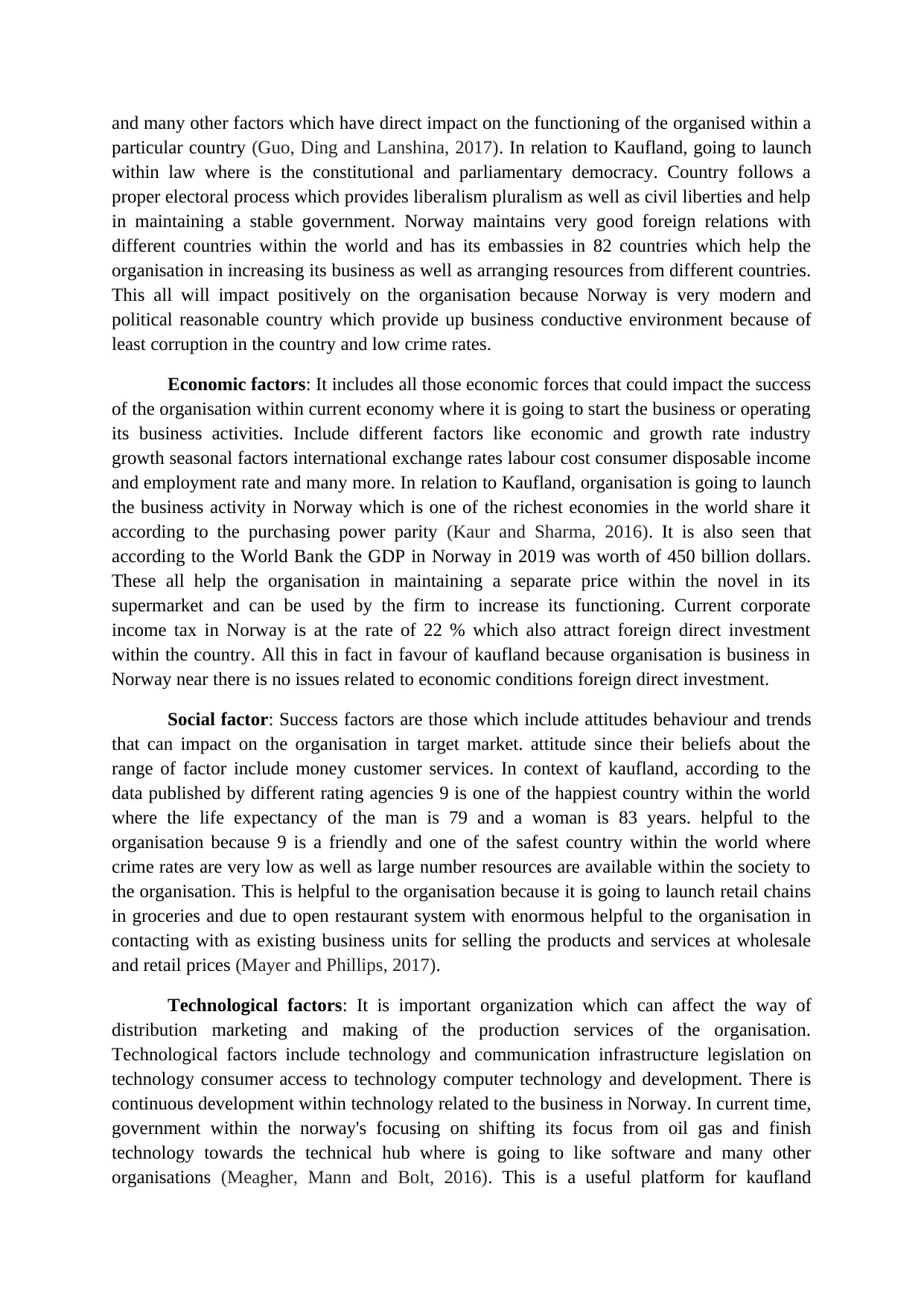
and many other factors which have direct impact on the functioning of the organised within a
particular country (Guo, Ding and Lanshina, 2017). In relation to Kaufland, going to launch
within law where is the constitutional and parliamentary democracy. Country follows a
proper electoral process which provides liberalism pluralism as well as civil liberties and help
in maintaining a stable government. Norway maintains very good foreign relations with
different countries within the world and has its embassies in 82 countries which help the
organisation in increasing its business as well as arranging resources from different countries.
This all will impact positively on the organisation because Norway is very modern and
political reasonable country which provide up business conductive environment because of
least corruption in the country and low crime rates.
Economic factors: It includes all those economic forces that could impact the success
of the organisation within current economy where it is going to start the business or operating
its business activities. Include different factors like economic and growth rate industry
growth seasonal factors international exchange rates labour cost consumer disposable income
and employment rate and many more. In relation to Kaufland, organisation is going to launch
the business activity in Norway which is one of the richest economies in the world share it
according to the purchasing power parity (Kaur and Sharma, 2016). It is also seen that
according to the World Bank the GDP in Norway in 2019 was worth of 450 billion dollars.
These all help the organisation in maintaining a separate price within the novel in its
supermarket and can be used by the firm to increase its functioning. Current corporate
income tax in Norway is at the rate of 22 % which also attract foreign direct investment
within the country. All this in fact in favour of kaufland because organisation is business in
Norway near there is no issues related to economic conditions foreign direct investment.
Social factor: Success factors are those which include attitudes behaviour and trends
that can impact on the organisation in target market. attitude since their beliefs about the
range of factor include money customer services. In context of kaufland, according to the
data published by different rating agencies 9 is one of the happiest country within the world
where the life expectancy of the man is 79 and a woman is 83 years. helpful to the
organisation because 9 is a friendly and one of the safest country within the world where
crime rates are very low as well as large number resources are available within the society to
the organisation. This is helpful to the organisation because it is going to launch retail chains
in groceries and due to open restaurant system with enormous helpful to the organisation in
contacting with as existing business units for selling the products and services at wholesale
and retail prices (Mayer and Phillips, 2017).
Technological factors: It is important organization which can affect the way of
distribution marketing and making of the production services of the organisation.
Technological factors include technology and communication infrastructure legislation on
technology consumer access to technology computer technology and development. There is
continuous development within technology related to the business in Norway. In current time,
government within the norway's focusing on shifting its focus from oil gas and finish
technology towards the technical hub where is going to like software and many other
organisations (Meagher, Mann and Bolt, 2016). This is a useful platform for kaufland
particular country (Guo, Ding and Lanshina, 2017). In relation to Kaufland, going to launch
within law where is the constitutional and parliamentary democracy. Country follows a
proper electoral process which provides liberalism pluralism as well as civil liberties and help
in maintaining a stable government. Norway maintains very good foreign relations with
different countries within the world and has its embassies in 82 countries which help the
organisation in increasing its business as well as arranging resources from different countries.
This all will impact positively on the organisation because Norway is very modern and
political reasonable country which provide up business conductive environment because of
least corruption in the country and low crime rates.
Economic factors: It includes all those economic forces that could impact the success
of the organisation within current economy where it is going to start the business or operating
its business activities. Include different factors like economic and growth rate industry
growth seasonal factors international exchange rates labour cost consumer disposable income
and employment rate and many more. In relation to Kaufland, organisation is going to launch
the business activity in Norway which is one of the richest economies in the world share it
according to the purchasing power parity (Kaur and Sharma, 2016). It is also seen that
according to the World Bank the GDP in Norway in 2019 was worth of 450 billion dollars.
These all help the organisation in maintaining a separate price within the novel in its
supermarket and can be used by the firm to increase its functioning. Current corporate
income tax in Norway is at the rate of 22 % which also attract foreign direct investment
within the country. All this in fact in favour of kaufland because organisation is business in
Norway near there is no issues related to economic conditions foreign direct investment.
Social factor: Success factors are those which include attitudes behaviour and trends
that can impact on the organisation in target market. attitude since their beliefs about the
range of factor include money customer services. In context of kaufland, according to the
data published by different rating agencies 9 is one of the happiest country within the world
where the life expectancy of the man is 79 and a woman is 83 years. helpful to the
organisation because 9 is a friendly and one of the safest country within the world where
crime rates are very low as well as large number resources are available within the society to
the organisation. This is helpful to the organisation because it is going to launch retail chains
in groceries and due to open restaurant system with enormous helpful to the organisation in
contacting with as existing business units for selling the products and services at wholesale
and retail prices (Mayer and Phillips, 2017).
Technological factors: It is important organization which can affect the way of
distribution marketing and making of the production services of the organisation.
Technological factors include technology and communication infrastructure legislation on
technology consumer access to technology computer technology and development. There is
continuous development within technology related to the business in Norway. In current time,
government within the norway's focusing on shifting its focus from oil gas and finish
technology towards the technical hub where is going to like software and many other
organisations (Meagher, Mann and Bolt, 2016). This is a useful platform for kaufland
Paraphrase This Document
Need a fresh take? Get an instant paraphrase of this document with our AI Paraphraser
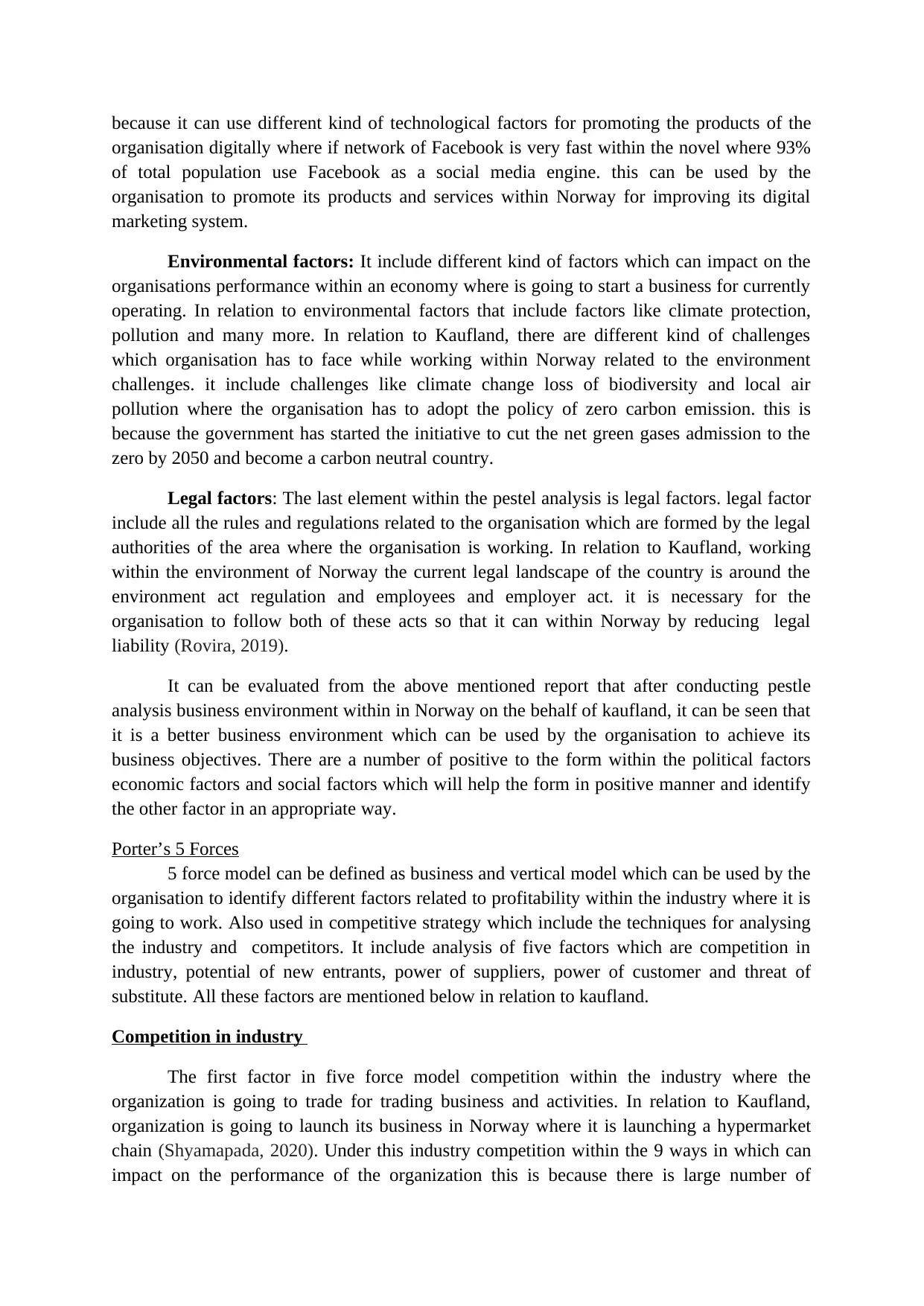
because it can use different kind of technological factors for promoting the products of the
organisation digitally where if network of Facebook is very fast within the novel where 93%
of total population use Facebook as a social media engine. this can be used by the
organisation to promote its products and services within Norway for improving its digital
marketing system.
Environmental factors: It include different kind of factors which can impact on the
organisations performance within an economy where is going to start a business for currently
operating. In relation to environmental factors that include factors like climate protection,
pollution and many more. In relation to Kaufland, there are different kind of challenges
which organisation has to face while working within Norway related to the environment
challenges. it include challenges like climate change loss of biodiversity and local air
pollution where the organisation has to adopt the policy of zero carbon emission. this is
because the government has started the initiative to cut the net green gases admission to the
zero by 2050 and become a carbon neutral country.
Legal factors: The last element within the pestel analysis is legal factors. legal factor
include all the rules and regulations related to the organisation which are formed by the legal
authorities of the area where the organisation is working. In relation to Kaufland, working
within the environment of Norway the current legal landscape of the country is around the
environment act regulation and employees and employer act. it is necessary for the
organisation to follow both of these acts so that it can within Norway by reducing legal
liability (Rovira, 2019).
It can be evaluated from the above mentioned report that after conducting pestle
analysis business environment within in Norway on the behalf of kaufland, it can be seen that
it is a better business environment which can be used by the organisation to achieve its
business objectives. There are a number of positive to the form within the political factors
economic factors and social factors which will help the form in positive manner and identify
the other factor in an appropriate way.
Porter’s 5 Forces
5 force model can be defined as business and vertical model which can be used by the
organisation to identify different factors related to profitability within the industry where it is
going to work. Also used in competitive strategy which include the techniques for analysing
the industry and competitors. It include analysis of five factors which are competition in
industry, potential of new entrants, power of suppliers, power of customer and threat of
substitute. All these factors are mentioned below in relation to kaufland.
Competition in industry
The first factor in five force model competition within the industry where the
organization is going to trade for trading business and activities. In relation to Kaufland,
organization is going to launch its business in Norway where it is launching a hypermarket
chain (Shyamapada, 2020). Under this industry competition within the 9 ways in which can
impact on the performance of the organization this is because there is large number of
organisation digitally where if network of Facebook is very fast within the novel where 93%
of total population use Facebook as a social media engine. this can be used by the
organisation to promote its products and services within Norway for improving its digital
marketing system.
Environmental factors: It include different kind of factors which can impact on the
organisations performance within an economy where is going to start a business for currently
operating. In relation to environmental factors that include factors like climate protection,
pollution and many more. In relation to Kaufland, there are different kind of challenges
which organisation has to face while working within Norway related to the environment
challenges. it include challenges like climate change loss of biodiversity and local air
pollution where the organisation has to adopt the policy of zero carbon emission. this is
because the government has started the initiative to cut the net green gases admission to the
zero by 2050 and become a carbon neutral country.
Legal factors: The last element within the pestel analysis is legal factors. legal factor
include all the rules and regulations related to the organisation which are formed by the legal
authorities of the area where the organisation is working. In relation to Kaufland, working
within the environment of Norway the current legal landscape of the country is around the
environment act regulation and employees and employer act. it is necessary for the
organisation to follow both of these acts so that it can within Norway by reducing legal
liability (Rovira, 2019).
It can be evaluated from the above mentioned report that after conducting pestle
analysis business environment within in Norway on the behalf of kaufland, it can be seen that
it is a better business environment which can be used by the organisation to achieve its
business objectives. There are a number of positive to the form within the political factors
economic factors and social factors which will help the form in positive manner and identify
the other factor in an appropriate way.
Porter’s 5 Forces
5 force model can be defined as business and vertical model which can be used by the
organisation to identify different factors related to profitability within the industry where it is
going to work. Also used in competitive strategy which include the techniques for analysing
the industry and competitors. It include analysis of five factors which are competition in
industry, potential of new entrants, power of suppliers, power of customer and threat of
substitute. All these factors are mentioned below in relation to kaufland.
Competition in industry
The first factor in five force model competition within the industry where the
organization is going to trade for trading business and activities. In relation to Kaufland,
organization is going to launch its business in Norway where it is launching a hypermarket
chain (Shyamapada, 2020). Under this industry competition within the 9 ways in which can
impact on the performance of the organization this is because there is large number of
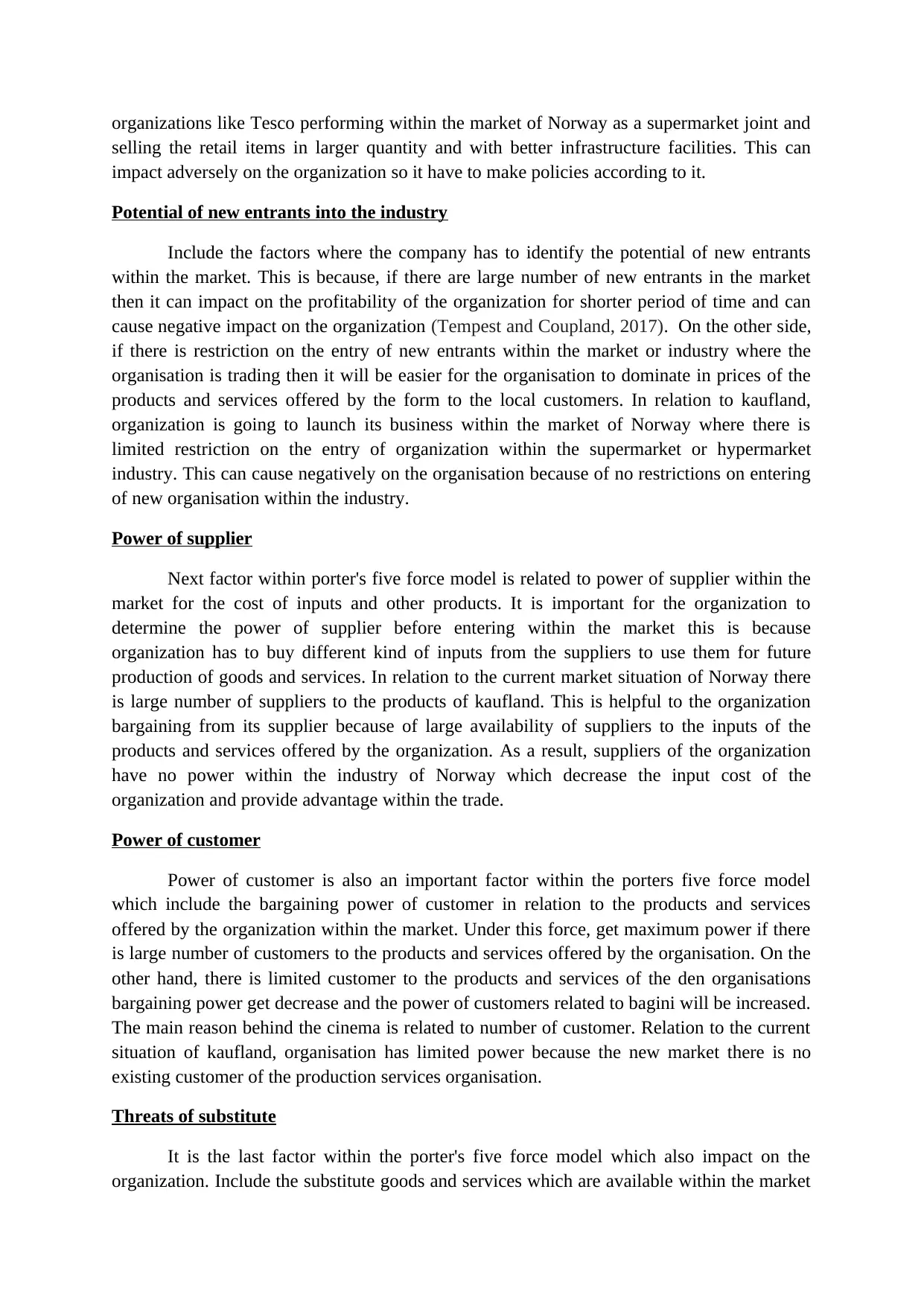
organizations like Tesco performing within the market of Norway as a supermarket joint and
selling the retail items in larger quantity and with better infrastructure facilities. This can
impact adversely on the organization so it have to make policies according to it.
Potential of new entrants into the industry
Include the factors where the company has to identify the potential of new entrants
within the market. This is because, if there are large number of new entrants in the market
then it can impact on the profitability of the organization for shorter period of time and can
cause negative impact on the organization (Tempest and Coupland, 2017). On the other side,
if there is restriction on the entry of new entrants within the market or industry where the
organisation is trading then it will be easier for the organisation to dominate in prices of the
products and services offered by the form to the local customers. In relation to kaufland,
organization is going to launch its business within the market of Norway where there is
limited restriction on the entry of organization within the supermarket or hypermarket
industry. This can cause negatively on the organisation because of no restrictions on entering
of new organisation within the industry.
Power of supplier
Next factor within porter's five force model is related to power of supplier within the
market for the cost of inputs and other products. It is important for the organization to
determine the power of supplier before entering within the market this is because
organization has to buy different kind of inputs from the suppliers to use them for future
production of goods and services. In relation to the current market situation of Norway there
is large number of suppliers to the products of kaufland. This is helpful to the organization
bargaining from its supplier because of large availability of suppliers to the inputs of the
products and services offered by the organization. As a result, suppliers of the organization
have no power within the industry of Norway which decrease the input cost of the
organization and provide advantage within the trade.
Power of customer
Power of customer is also an important factor within the porters five force model
which include the bargaining power of customer in relation to the products and services
offered by the organization within the market. Under this force, get maximum power if there
is large number of customers to the products and services offered by the organisation. On the
other hand, there is limited customer to the products and services of the den organisations
bargaining power get decrease and the power of customers related to bagini will be increased.
The main reason behind the cinema is related to number of customer. Relation to the current
situation of kaufland, organisation has limited power because the new market there is no
existing customer of the production services organisation.
Threats of substitute
It is the last factor within the porter's five force model which also impact on the
organization. Include the substitute goods and services which are available within the market
selling the retail items in larger quantity and with better infrastructure facilities. This can
impact adversely on the organization so it have to make policies according to it.
Potential of new entrants into the industry
Include the factors where the company has to identify the potential of new entrants
within the market. This is because, if there are large number of new entrants in the market
then it can impact on the profitability of the organization for shorter period of time and can
cause negative impact on the organization (Tempest and Coupland, 2017). On the other side,
if there is restriction on the entry of new entrants within the market or industry where the
organisation is trading then it will be easier for the organisation to dominate in prices of the
products and services offered by the form to the local customers. In relation to kaufland,
organization is going to launch its business within the market of Norway where there is
limited restriction on the entry of organization within the supermarket or hypermarket
industry. This can cause negatively on the organisation because of no restrictions on entering
of new organisation within the industry.
Power of supplier
Next factor within porter's five force model is related to power of supplier within the
market for the cost of inputs and other products. It is important for the organization to
determine the power of supplier before entering within the market this is because
organization has to buy different kind of inputs from the suppliers to use them for future
production of goods and services. In relation to the current market situation of Norway there
is large number of suppliers to the products of kaufland. This is helpful to the organization
bargaining from its supplier because of large availability of suppliers to the inputs of the
products and services offered by the organization. As a result, suppliers of the organization
have no power within the industry of Norway which decrease the input cost of the
organization and provide advantage within the trade.
Power of customer
Power of customer is also an important factor within the porters five force model
which include the bargaining power of customer in relation to the products and services
offered by the organization within the market. Under this force, get maximum power if there
is large number of customers to the products and services offered by the organisation. On the
other hand, there is limited customer to the products and services of the den organisations
bargaining power get decrease and the power of customers related to bagini will be increased.
The main reason behind the cinema is related to number of customer. Relation to the current
situation of kaufland, organisation has limited power because the new market there is no
existing customer of the production services organisation.
Threats of substitute
It is the last factor within the porter's five force model which also impact on the
organization. Include the substitute goods and services which are available within the market
⊘ This is a preview!⊘
Do you want full access?
Subscribe today to unlock all pages.

Trusted by 1+ million students worldwide
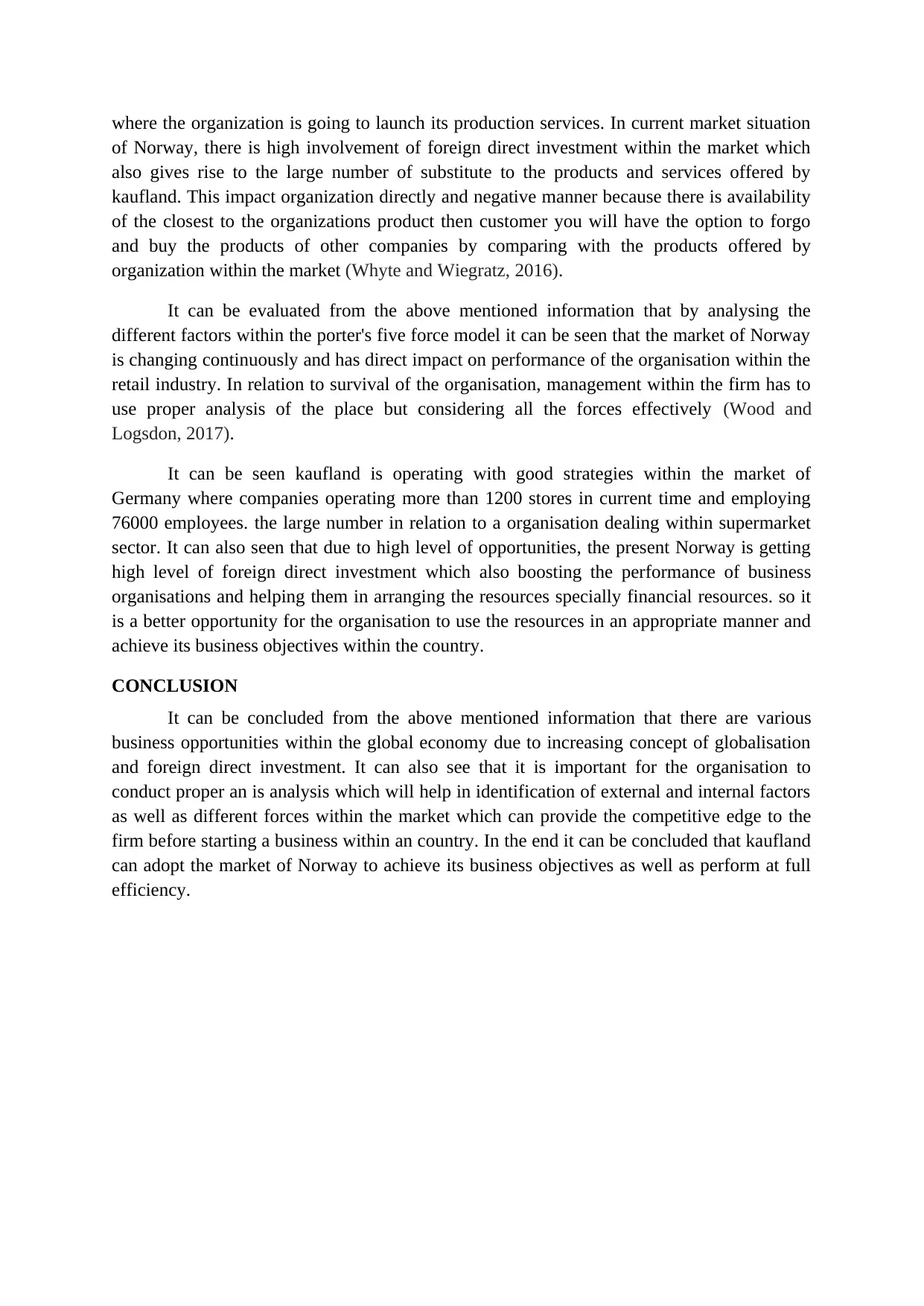
where the organization is going to launch its production services. In current market situation
of Norway, there is high involvement of foreign direct investment within the market which
also gives rise to the large number of substitute to the products and services offered by
kaufland. This impact organization directly and negative manner because there is availability
of the closest to the organizations product then customer you will have the option to forgo
and buy the products of other companies by comparing with the products offered by
organization within the market (Whyte and Wiegratz, 2016).
It can be evaluated from the above mentioned information that by analysing the
different factors within the porter's five force model it can be seen that the market of Norway
is changing continuously and has direct impact on performance of the organisation within the
retail industry. In relation to survival of the organisation, management within the firm has to
use proper analysis of the place but considering all the forces effectively (Wood and
Logsdon, 2017).
It can be seen kaufland is operating with good strategies within the market of
Germany where companies operating more than 1200 stores in current time and employing
76000 employees. the large number in relation to a organisation dealing within supermarket
sector. It can also seen that due to high level of opportunities, the present Norway is getting
high level of foreign direct investment which also boosting the performance of business
organisations and helping them in arranging the resources specially financial resources. so it
is a better opportunity for the organisation to use the resources in an appropriate manner and
achieve its business objectives within the country.
CONCLUSION
It can be concluded from the above mentioned information that there are various
business opportunities within the global economy due to increasing concept of globalisation
and foreign direct investment. It can also see that it is important for the organisation to
conduct proper an is analysis which will help in identification of external and internal factors
as well as different forces within the market which can provide the competitive edge to the
firm before starting a business within an country. In the end it can be concluded that kaufland
can adopt the market of Norway to achieve its business objectives as well as perform at full
efficiency.
of Norway, there is high involvement of foreign direct investment within the market which
also gives rise to the large number of substitute to the products and services offered by
kaufland. This impact organization directly and negative manner because there is availability
of the closest to the organizations product then customer you will have the option to forgo
and buy the products of other companies by comparing with the products offered by
organization within the market (Whyte and Wiegratz, 2016).
It can be evaluated from the above mentioned information that by analysing the
different factors within the porter's five force model it can be seen that the market of Norway
is changing continuously and has direct impact on performance of the organisation within the
retail industry. In relation to survival of the organisation, management within the firm has to
use proper analysis of the place but considering all the forces effectively (Wood and
Logsdon, 2017).
It can be seen kaufland is operating with good strategies within the market of
Germany where companies operating more than 1200 stores in current time and employing
76000 employees. the large number in relation to a organisation dealing within supermarket
sector. It can also seen that due to high level of opportunities, the present Norway is getting
high level of foreign direct investment which also boosting the performance of business
organisations and helping them in arranging the resources specially financial resources. so it
is a better opportunity for the organisation to use the resources in an appropriate manner and
achieve its business objectives within the country.
CONCLUSION
It can be concluded from the above mentioned information that there are various
business opportunities within the global economy due to increasing concept of globalisation
and foreign direct investment. It can also see that it is important for the organisation to
conduct proper an is analysis which will help in identification of external and internal factors
as well as different forces within the market which can provide the competitive edge to the
firm before starting a business within an country. In the end it can be concluded that kaufland
can adopt the market of Norway to achieve its business objectives as well as perform at full
efficiency.
Paraphrase This Document
Need a fresh take? Get an instant paraphrase of this document with our AI Paraphraser
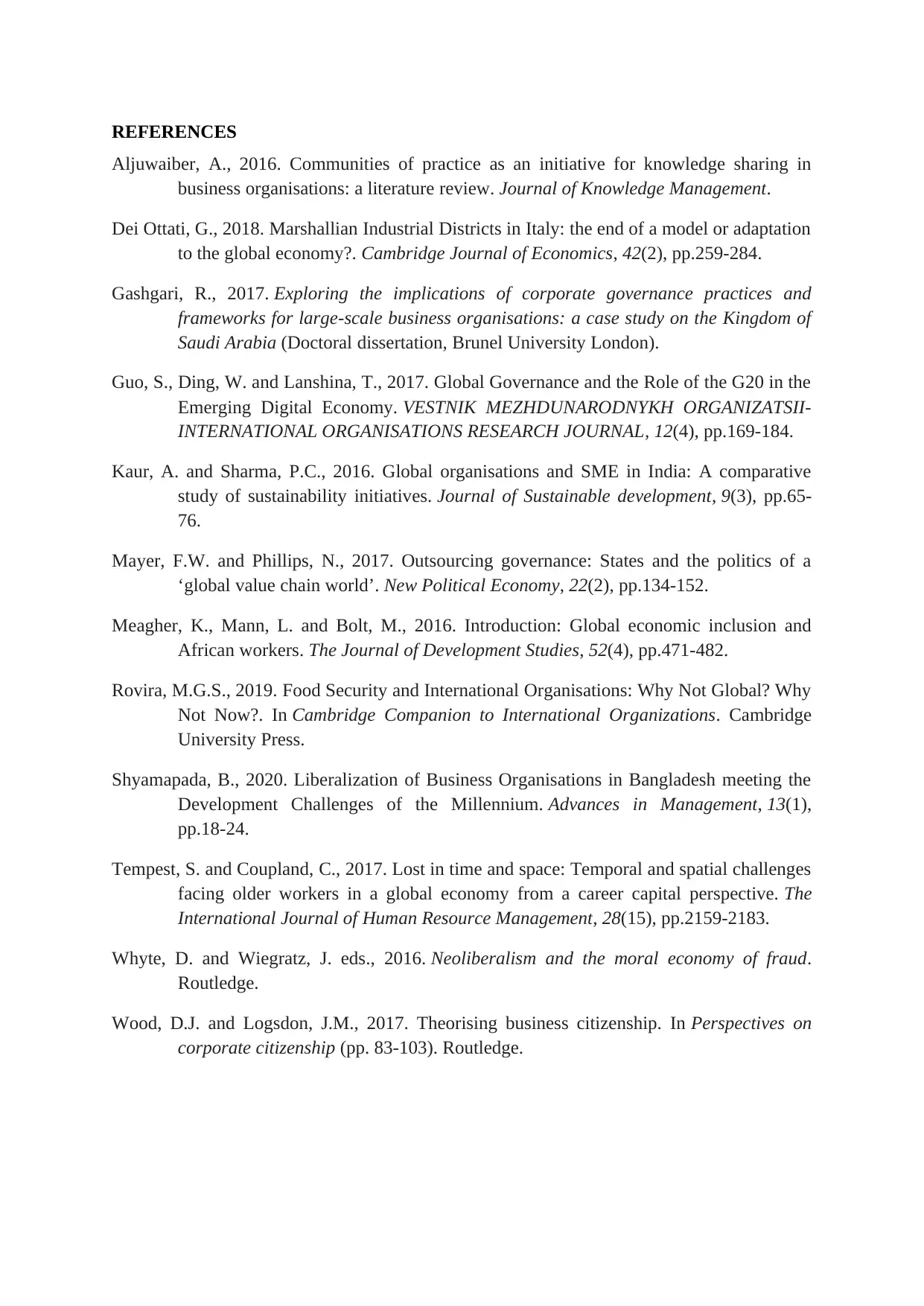
REFERENCES
Aljuwaiber, A., 2016. Communities of practice as an initiative for knowledge sharing in
business organisations: a literature review. Journal of Knowledge Management.
Dei Ottati, G., 2018. Marshallian Industrial Districts in Italy: the end of a model or adaptation
to the global economy?. Cambridge Journal of Economics, 42(2), pp.259-284.
Gashgari, R., 2017. Exploring the implications of corporate governance practices and
frameworks for large-scale business organisations: a case study on the Kingdom of
Saudi Arabia (Doctoral dissertation, Brunel University London).
Guo, S., Ding, W. and Lanshina, T., 2017. Global Governance and the Role of the G20 in the
Emerging Digital Economy. VESTNIK MEZHDUNARODNYKH ORGANIZATSII-
INTERNATIONAL ORGANISATIONS RESEARCH JOURNAL, 12(4), pp.169-184.
Kaur, A. and Sharma, P.C., 2016. Global organisations and SME in India: A comparative
study of sustainability initiatives. Journal of Sustainable development, 9(3), pp.65-
76.
Mayer, F.W. and Phillips, N., 2017. Outsourcing governance: States and the politics of a
‘global value chain world’. New Political Economy, 22(2), pp.134-152.
Meagher, K., Mann, L. and Bolt, M., 2016. Introduction: Global economic inclusion and
African workers. The Journal of Development Studies, 52(4), pp.471-482.
Rovira, M.G.S., 2019. Food Security and International Organisations: Why Not Global? Why
Not Now?. In Cambridge Companion to International Organizations. Cambridge
University Press.
Shyamapada, B., 2020. Liberalization of Business Organisations in Bangladesh meeting the
Development Challenges of the Millennium. Advances in Management, 13(1),
pp.18-24.
Tempest, S. and Coupland, C., 2017. Lost in time and space: Temporal and spatial challenges
facing older workers in a global economy from a career capital perspective. The
International Journal of Human Resource Management, 28(15), pp.2159-2183.
Whyte, D. and Wiegratz, J. eds., 2016. Neoliberalism and the moral economy of fraud.
Routledge.
Wood, D.J. and Logsdon, J.M., 2017. Theorising business citizenship. In Perspectives on
corporate citizenship (pp. 83-103). Routledge.
Aljuwaiber, A., 2016. Communities of practice as an initiative for knowledge sharing in
business organisations: a literature review. Journal of Knowledge Management.
Dei Ottati, G., 2018. Marshallian Industrial Districts in Italy: the end of a model or adaptation
to the global economy?. Cambridge Journal of Economics, 42(2), pp.259-284.
Gashgari, R., 2017. Exploring the implications of corporate governance practices and
frameworks for large-scale business organisations: a case study on the Kingdom of
Saudi Arabia (Doctoral dissertation, Brunel University London).
Guo, S., Ding, W. and Lanshina, T., 2017. Global Governance and the Role of the G20 in the
Emerging Digital Economy. VESTNIK MEZHDUNARODNYKH ORGANIZATSII-
INTERNATIONAL ORGANISATIONS RESEARCH JOURNAL, 12(4), pp.169-184.
Kaur, A. and Sharma, P.C., 2016. Global organisations and SME in India: A comparative
study of sustainability initiatives. Journal of Sustainable development, 9(3), pp.65-
76.
Mayer, F.W. and Phillips, N., 2017. Outsourcing governance: States and the politics of a
‘global value chain world’. New Political Economy, 22(2), pp.134-152.
Meagher, K., Mann, L. and Bolt, M., 2016. Introduction: Global economic inclusion and
African workers. The Journal of Development Studies, 52(4), pp.471-482.
Rovira, M.G.S., 2019. Food Security and International Organisations: Why Not Global? Why
Not Now?. In Cambridge Companion to International Organizations. Cambridge
University Press.
Shyamapada, B., 2020. Liberalization of Business Organisations in Bangladesh meeting the
Development Challenges of the Millennium. Advances in Management, 13(1),
pp.18-24.
Tempest, S. and Coupland, C., 2017. Lost in time and space: Temporal and spatial challenges
facing older workers in a global economy from a career capital perspective. The
International Journal of Human Resource Management, 28(15), pp.2159-2183.
Whyte, D. and Wiegratz, J. eds., 2016. Neoliberalism and the moral economy of fraud.
Routledge.
Wood, D.J. and Logsdon, J.M., 2017. Theorising business citizenship. In Perspectives on
corporate citizenship (pp. 83-103). Routledge.
1 out of 8
Related Documents
Your All-in-One AI-Powered Toolkit for Academic Success.
+13062052269
info@desklib.com
Available 24*7 on WhatsApp / Email
![[object Object]](/_next/static/media/star-bottom.7253800d.svg)
Unlock your academic potential
Copyright © 2020–2025 A2Z Services. All Rights Reserved. Developed and managed by ZUCOL.





